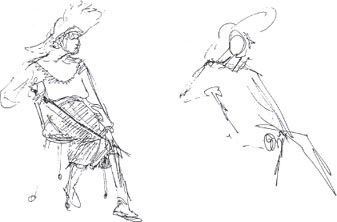I often speak of angles in drawing. Sometimes I get a blank look. I finally decided to look the word up in the dictionary to hopefully find a definition that would apply to drawing. I didn’t get much help, for it stated that an angle is the shape made by two straight lines meeting in a point, or by two plane surfaces meeting at a point. That meaning might apply to an arm bending at the elbow, but in drawing there are numerous angles that do not meet at a point; for instance, a person’s legs while sitting or running.

In mathematics the acuteness of an angle is measured in degrees with 45 degrees as a pretty well-known angle. Almost anyone can describe a 45 degree angle without a protractor. An artist’s perception of an angle is not measured in degrees, but just whatever angle best serves his purposes in describing a gesture. The intensity of the angle usually depends on the intensity of the emotion or mood behind the pose, or the need to use a convincing angle to make the gesture seem physically logical.
Here is one artist’s drawing of the model leaning back in a chair in a somewhat relaxed manner. To make it more logical I increased the angle of her body and angled her shoulders — after all her right arm is lifted over the chair back and the other arm is reaching down to her knees (pulling the left shoulder down with it). The more acute angle of the body puts some weight into the lean, and gives a reason for the neck stretching forward. Remember that if a model, or anyone for that matter, looks natural in a pose, it’s because their body just naturally does these things. We all have learned enough body language to express things bodily. In drawing it is different — there is a thought process that has to be consulted and activated. In effect your pencil has to be directed to do what your body does unprompted. (see the drawing below).

Here is another drawing that is quite nice. All the elements are well drawn, but the angle of the magazine disturbed me. I felt the look was glancing off the magazine page and carrying our attention off to the right. I suggested lifting the left side of the magazine so the audience’s attention would be corralled, so to speak, in that all-important area between the eyes and the magazine — the area I call the “stage” of the drawing. That is where the drama is taking place. Also I angled the shoulders differently to accelerate the look in the direction of the magazine.

Angles refer not just to lines but to surfaces or planes as well. Notice on the previous figure that the whole surface, though it is curved, angles toward her eyes — not just the lines but the whole plane of the page. Likewise not just the angle of the head and eyes, but the plane of her face points toward the page. In just drawing a magazine one might spend a lot of time drawing the details but neglect to select a contributive angle — one that helps the gesture or the story point. There must be purpose behind everything you draw, and in animation, story is that purpose or the raison d’être.
Here is another drawing, same pose, different view. Nice drawing, but this time it’s the head angle that’s off. That is, unless according to the story she was reading and watching TV at the same time.

Last week we had a wonderful model named Bobby Ruth Mann. She was no “spring chicken” but she was full of fun, and a good actor. Lureline Weatherly seems to have charmed this beautiful drawing into being. The suggested story was a gypsy woman adjusting a rose in her hair. It’s a very forceful and expressive juxtaposition of angles.

We had some male students join in the act to set up a relationship to draw. Here are three artist’s drawings of the same pose. Roger Chiasson’s on the left, Dave Woodman’s below that, and I apologize for being unable to identify the other artist (I tried). In all these drawings there is an intense concentration of interest in what the gentleman is pointing at. The problem was to establish a relationship between the two. Notice how that relationship was realized by the use of angles — angles of lines, planes, and negative spaces. One word summary:
THRILLING.

